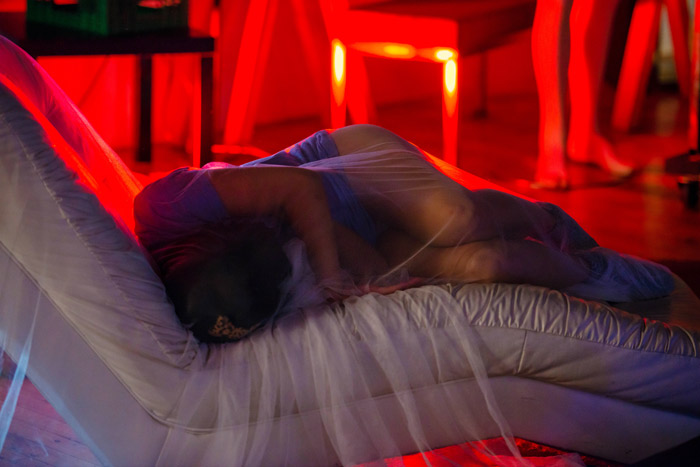TAME, a new exhibition showcasing dance by choreographer Lara Kramer immerses its audience in a world of dreamy experimentation through unconventional movement.
The set of TAME was reminiscent of a first apartment, stuffed with the gleeful accumulation of garish, yet cohesive ‘70s and ‘80s ephemera. Crowded with clothing and magazines, the stage of TAME felt familiar—like an exaggerated version of an adolescent bedroom. According to the choreographer, the vintage set was developed over a course of two years; as the piece came together, so did the set’s theme. Most contemporary dance pieces are minimal in their costuming and stage design; presumably not to distract from the dancers’ movements, however, the busy set of TAME didn’t draw away from the dancer’s performance at all—in fact, it was much more engaging and cohesive with the concept behind the piece.
In this informal environment, the three dancers experimented with concepts of physical, mental, and personal space. This aforementioned space was created and manipulated through interaction and movement between props and bodies, often in bizarre or comical ways. Kramer excellently utilized props such as rope, marshmallows, popcorn, and paper towels to raise questions about the space within humans and the space that they occupy on a daily basis.
An eerie silence was interrupted by the soft sound, akin to the crackling of paper, as one dancer sat in a wheelchair covered in medical paper, before the loud music and screaming was reduced once again to silence. One of the best moments of the piece was when a wild dance party deteriorated into a screaming tantrum, which eventually subsided to reveal an orchestral cover of “Hotel California” playing softly from an onstage stereo.
However, the set wasn’t the only theatrical element of the piece. The three dancers developed their characters distinctly through small solo sections that utilized different props. There were sections with interaction between the dancers, but often, the three performers separately experimented the space around them. But whilst the theatrical elements were organic and the dialogue between the characters dramatic, it ultimately felt out of place with the rest if the piece. The final product contained dialogue between the dancers, but it was mostly background noise—softly spoken and improvised.
The beginning of the piece was hardly recognizable as a dance production, and instead felt more like the opening scene of a play, whilst the dancers’ movements were subtle yet affected. The simple act of walking across a room, feeling one’s feet on the floor, or turning the pages of a magazine were elegant and careful—a reminder that every movement can be a part of a larger dance routine.
The nature of the choreography as well as the props provided room for improvisation. Instead of a strict choreography where the audience could often anticipate dancers’ next movements, like in music, this choreography was constantly surprising and changing, which made the show all the more engaging and comedic. Spontaneous moments such as a glass full of juice spilling onto the floor made the scene feel more immersive and real.
At some points, the sexual nature of the piece wasn’t explicitly obvious. The characters in the show are all presented as sexual beings in an entirely natural way. For example, the causal femininity of their costumes—one wore a crop top and tights, another shuffled around in slippers, underwear, and a quintessential ‘80s windbreaker—revealed the natural, languid, and comfortable femininity that many women wear while not in the male gaze. Other moments were more obvious, such as when one dancer used a rope hanging from the ceiling in an amateur quasi-pole dance, or when another pretended to be a male masturbating to the TV.
TAME was exciting in the way characterization and media such as props and music were used to discover different experiences of individuals and the space they inhabit. Subtle movements and sounds were juxtaposed with dazzling and bizarre displays of energy to create an enchanting and provocative experience.









